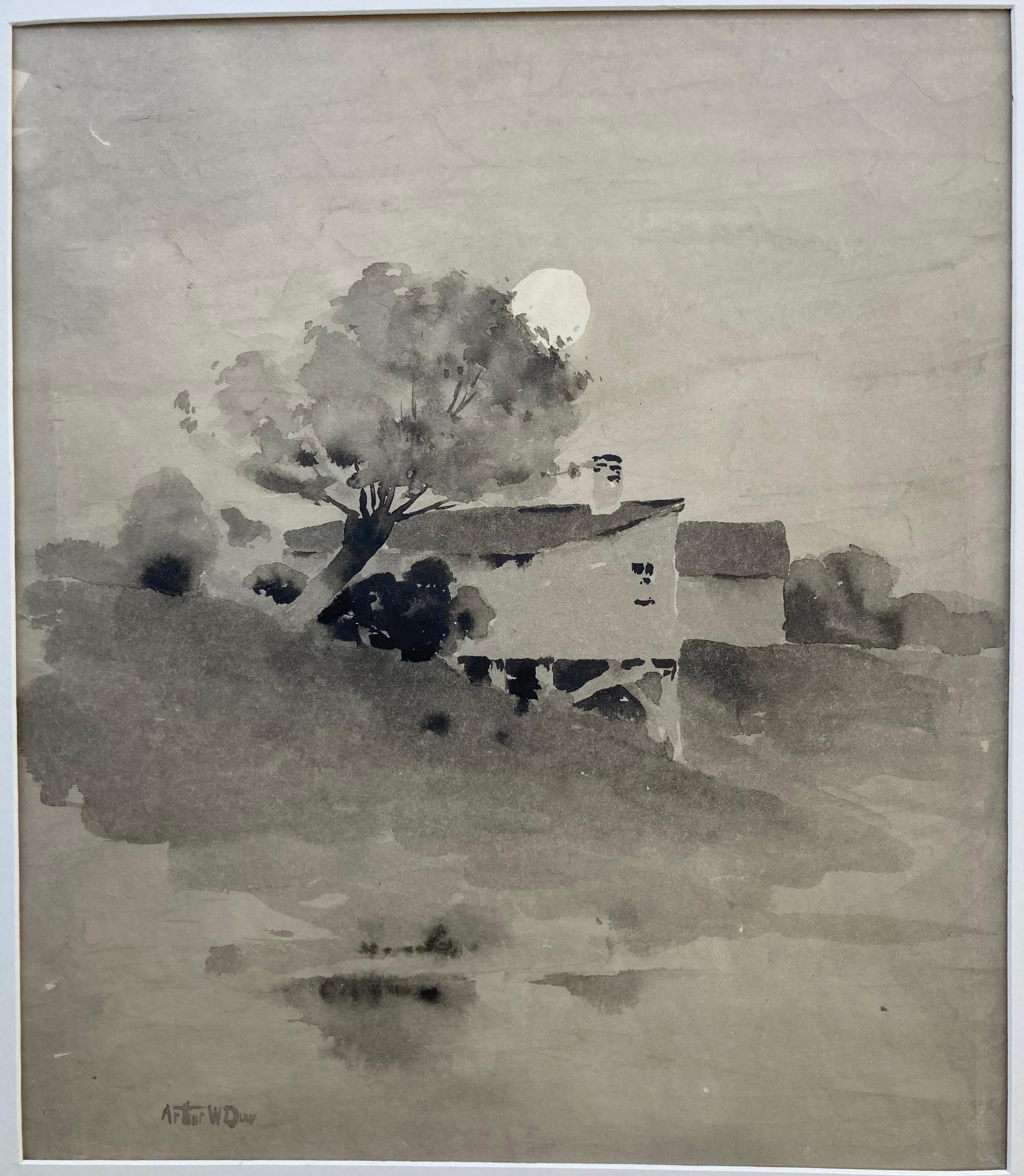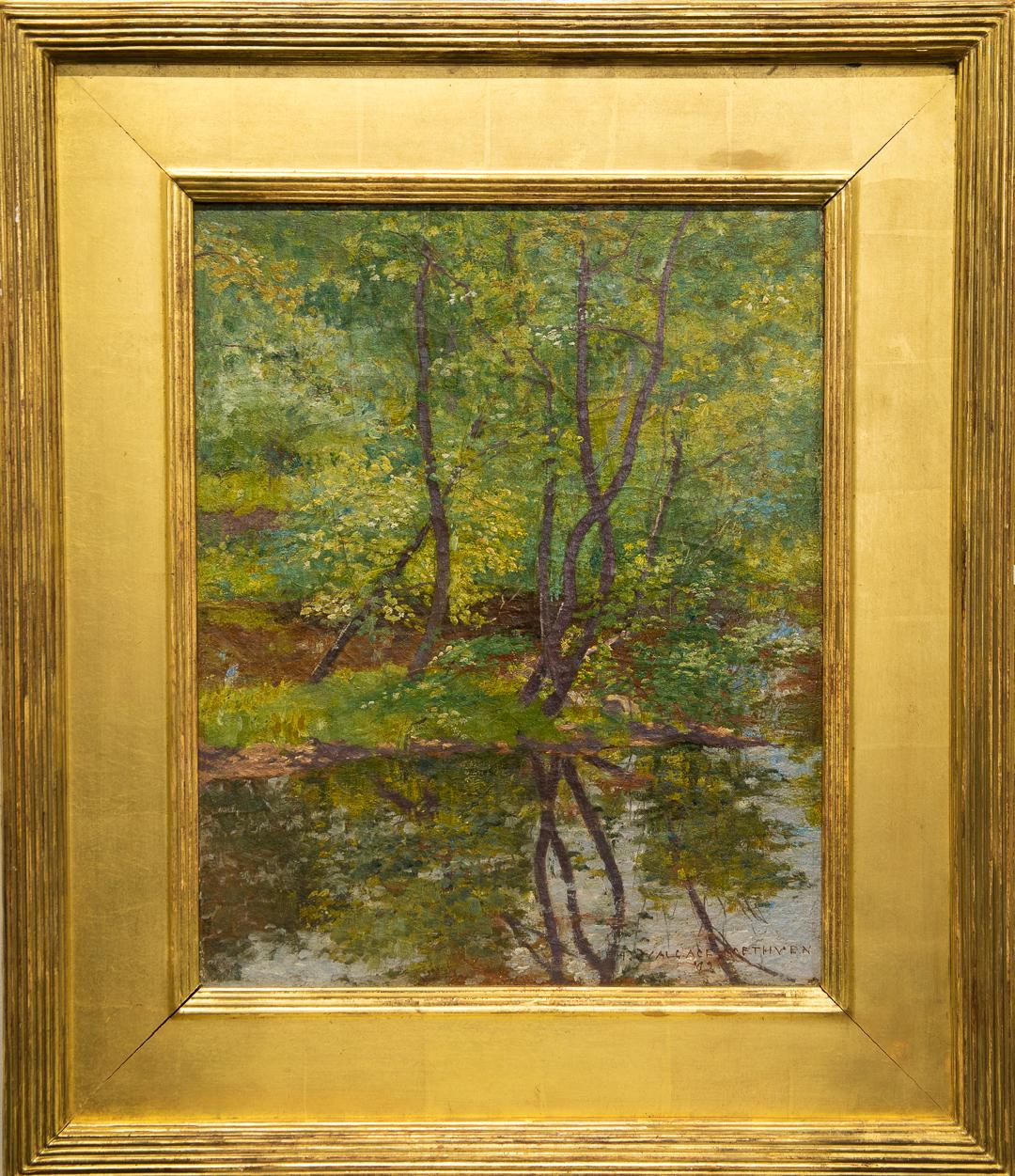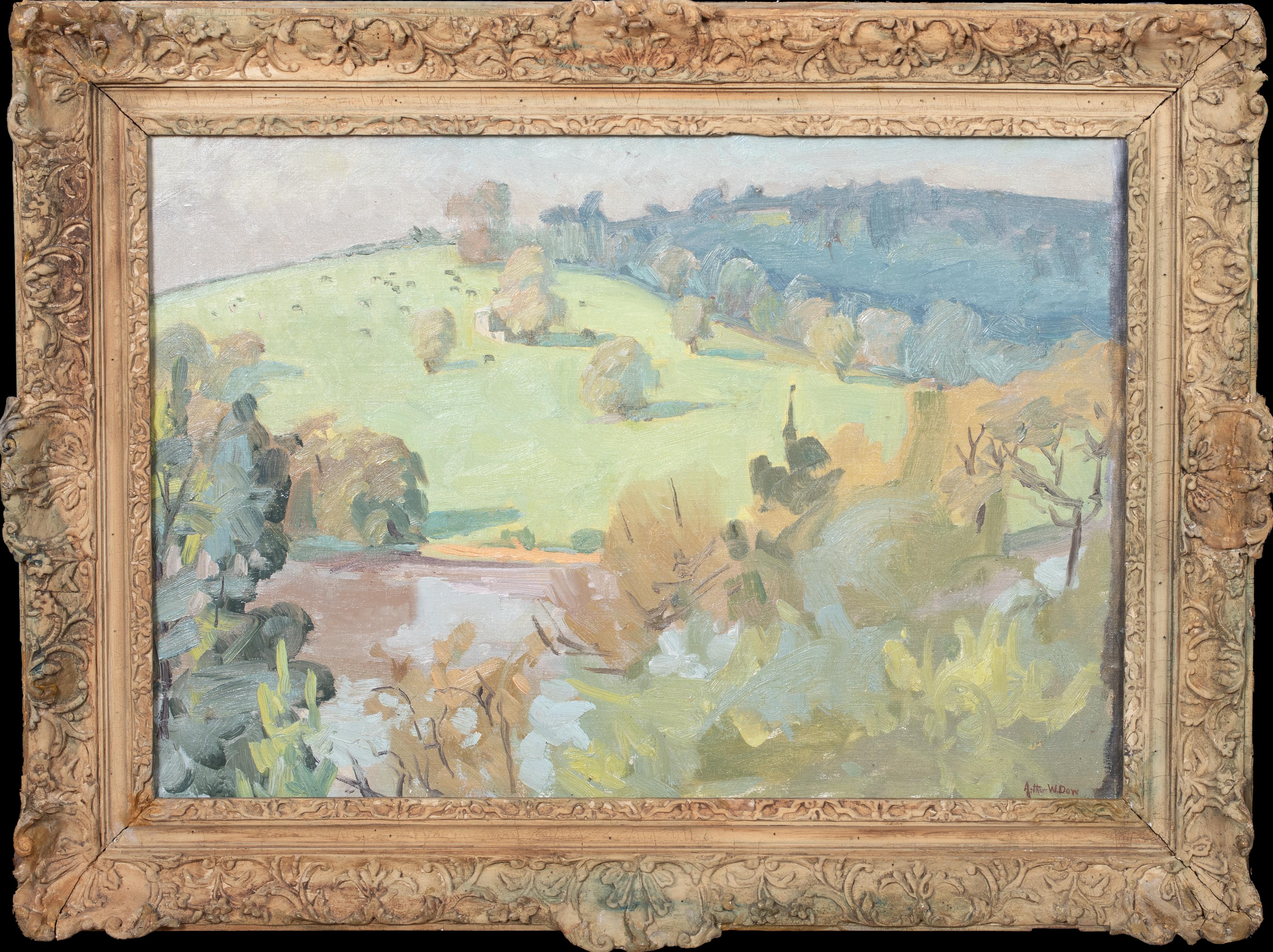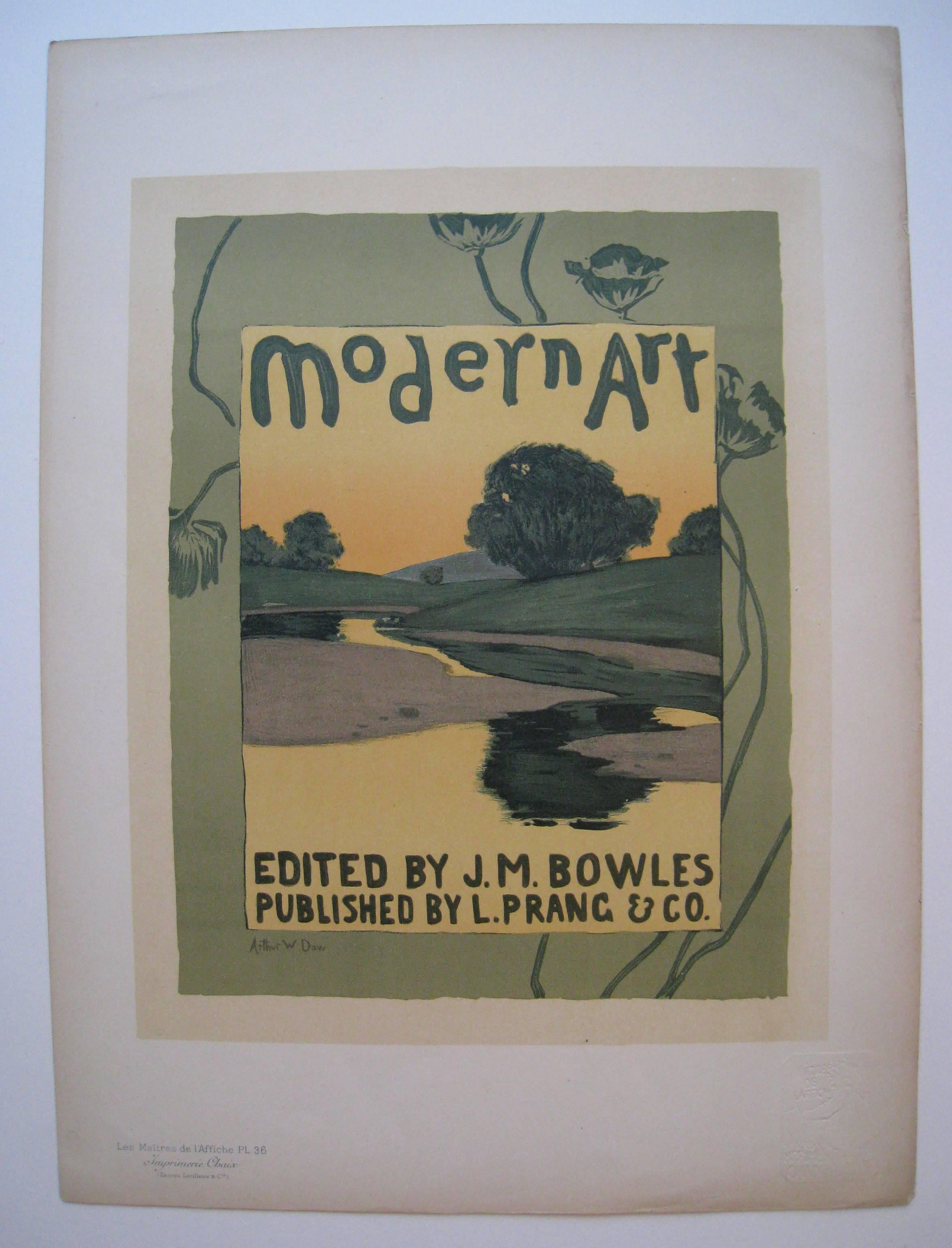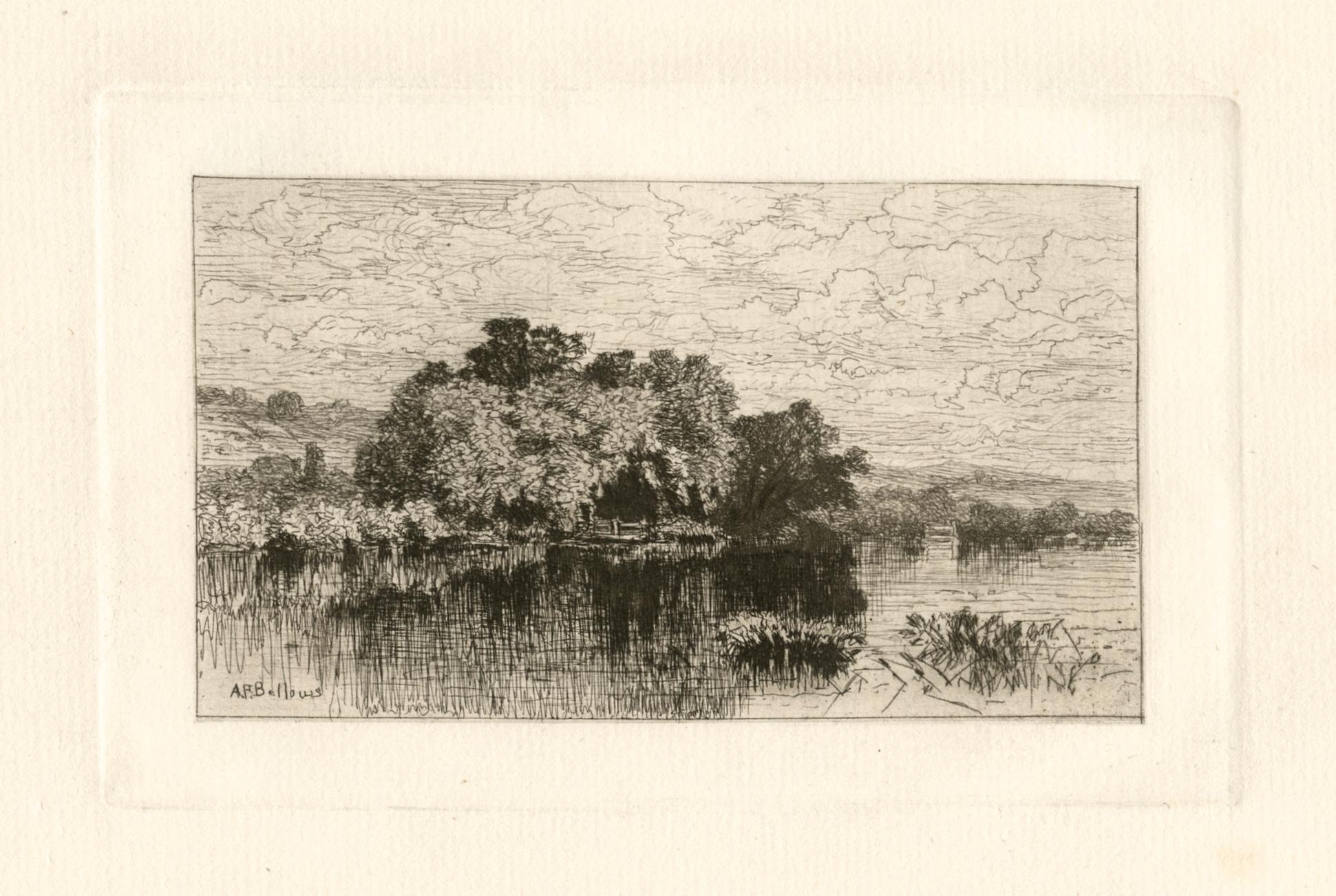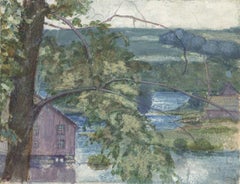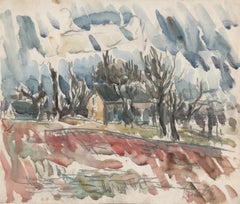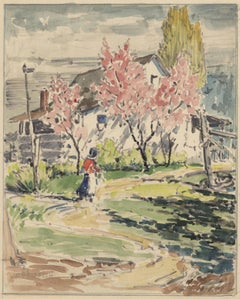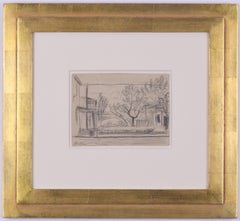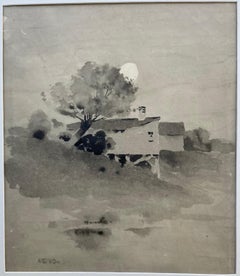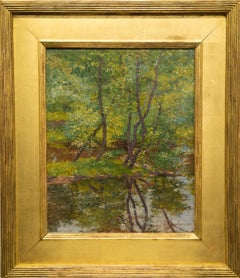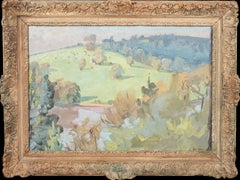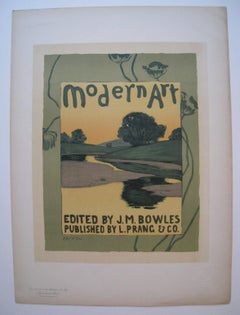Items Similar to River Reflections
Want more images or videos?
Request additional images or videos from the seller
1 of 5
Arthur Wesley DowRiver Reflectionsc. 1910
c. 1910
$2,950
£2,226.28
€2,548.76
CA$4,160.48
A$4,567.69
CHF 2,382.97
MX$55,275.36
NOK 29,866.85
SEK 28,142.42
DKK 19,025.80
About the Item
River Reflections
Color woodcut, c. 1910
Unsigned
Provenance: Dow Family Album, Cincinnati
Condition: Excellent
Image size: 2 1/2 x 4 inches
Sheet size: 3 1/8 x 4 7/8”
A color variant printing from a very small edition
Note: I have seen five impressions of this image in 40 years. Of those, I have seen one signed impression (Private Collection, Indiana). This example has a light grey background. There are also variants with a darker grey background.
Most probably a view along the Ipswich River, although not identified by scholars.
- Creator:Arthur Wesley Dow (1857-1922, American)
- Creation Year:c. 1910
- Dimensions:Height: 2.5 in (6.35 cm)Width: 4 in (10.16 cm)
- Medium:
- Movement & Style:
- Period:
- Condition:
- Gallery Location:Fairlawn, OH
- Reference Number:Seller: FA107761stDibs: LU14014847612
About the Seller
5.0
Recognized Seller
These prestigious sellers are industry leaders and represent the highest echelon for item quality and design.
Platinum Seller
Premium sellers with a 4.7+ rating and 24-hour response times
Established in 1978
1stDibs seller since 2013
813 sales on 1stDibs
Typical response time: <1 hour
Associations
International Fine Print Dealers Association
- ShippingRetrieving quote...Shipping from: Fairlawn, OH
- Return Policy
Authenticity Guarantee
In the unlikely event there’s an issue with an item’s authenticity, contact us within 1 year for a full refund. DetailsMoney-Back Guarantee
If your item is not as described, is damaged in transit, or does not arrive, contact us within 7 days for a full refund. Details24-Hour Cancellation
You have a 24-hour grace period in which to reconsider your purchase, with no questions asked.Vetted Professional Sellers
Our world-class sellers must adhere to strict standards for service and quality, maintaining the integrity of our listings.Price-Match Guarantee
If you find that a seller listed the same item for a lower price elsewhere, we’ll match it.Trusted Global Delivery
Our best-in-class carrier network provides specialized shipping options worldwide, including custom delivery.More From This Seller
View AllUntitled
Located in Fairlawn, OH
Untitled
Watercolor on paper, c,. 1890
Unsigned
Provenance: Estate of the artist
Image/Sheet size: 3 1/4 x 4 1/8 inches
From Wikipedia
"Francis Augustus Lathrop (June 22, 1849 – Oct...
Category
1890s American Impressionist Landscape Drawings and Watercolors
Materials
Watercolor
Landscape with buildings and trees
By Leon Kelly
Located in Fairlawn, OH
Landscape with buildings and trees
Watercolor on paper, c. 1930's
Signed in pencil lower right (see photo)
Provenance: Estate of the artist
Condition: Excellent
Sheet size: 9 3/8 x 1...
Category
1930s American Modern Landscape Drawings and Watercolors
Materials
Watercolor
Spring Landscape with house and figure
By Louis Oscar Griffith
Located in Fairlawn, OH
Spring Landscape with house and figure
A preliminary watercolor for a color aquatint, illustrated on line, title unknown
Signed lower left in block letters (see photo)
Watercolor and...
Category
1920s American Impressionist Landscape Drawings and Watercolors
Materials
Watercolor
Brookdale, New Jersey
By Oscar Florianus Bluemner
Located in Fairlawn, OH
Brookdale, New Jersey
Graphite on paper, 1922
Signed with the artist's initials l.l., and dated 1922 (see photo)
Annotated "Brookdale" front and back of sheet
Condition: Excellent
Ar...
Category
1920s American Modern Landscape Drawings and Watercolors
Materials
Graphite
The River Barge
By David Cox
Located in Fairlawn, OH
The River Barge
Pen and ink on paper on laid paper, mounted in English drum mount , c. 1810
Unsigned
Condition: Slight sun staining to sheet and mount in the window (see photo)
Image/sheet size: 5 1/4 x 6 11/16 inches
Sight: : 5-3/4 x 7-1/4"
Frame: 13-3/8 x 14-3/8"
Provenance: Colnaghi, London (see photo of label)
David Cox (29 April 1783 – 7 June 1859) was an English landscape painter, one of the most important members of the Birmingham School of landscape artists and an early precursor of Impressionism.
He is considered one of the greatest English landscape painters, and a major figure of the Golden age of English watercolour.
Although most popularly known for his works in watercolour, he also painted over 300 works in oil towards the end of his career, now considered "one of the greatest, but least recognised, achievements of any British painter.
His son, known as David Cox the Younger (1809-1885), was also a successful artist.
Early life in Birmingham, 1783–1804
Cox's birthplace in Deritend, Birmingham, illustrated by Samuel Lines
Cox was born on 29 April 1783 on Heath Mill Lane in Deritend, then an industrial suburb of Birmingham. His father was a blacksmith and whitesmith about whom little is known, except that he supplied components such as bayonets and barrels to the Birmingham gun trade. Cox's mother was the daughter of a farmer and miller from Small Heath to the east of Birmingham. Early biographers record that "she had had a better education than his father, and was a woman of superior intelligence and force of character." Cox was initially expected to follow his father into the metal trade and take over his forge, but his lack of physical strength led his family to seek opportunities for him to develop his interest in art, which is said to have first become apparent when the young Cox started painting paper kites while recovering from a broken leg.
By the late 18th century Birmingham had developed a network of private academies teaching drawing and painting, established to support the needs of the town's manufacturers of luxury metal goods, but also encouraging education in fine art, and nurturing the distinctive tradition of landscape art of the Birmingham School. Cox initially enrolled in the academy of Joseph Barber in Great Charles Street, where fellow students included the artist Charles Barber and the engraver William Radclyffe, both of whom would become important lifelong friends.
At the age of about 15 Cox was apprenticed to the Birmingham painter Albert Fielder, who produced portrait miniatures and paintings for the tops of snuffboxes from his workshop at 10 Parade in the northwest of the town. Early biographers of Cox record that he left his apprenticeship after Fielder's suicide, with one reporting that Cox himself discovered his master's hanging body, but this is probably a myth as Fielder is recorded at his address in Parade as late as 1825. At some time during mid-1800 Cox was given work by William Macready the elder at the Birmingham Theatre, initially as an assistant grinding colours and preparing canvases for the scene painters, but from 1801 painting scenery himself and by 1802 leading his own team of assistants and being credited in plays' publicity.
London, 1804–1814
In 1804 Cox was promised work by the theatre impresario Philip Astley and moved to London, taking lodgings in 16 Bridge Row, Lambeth. Although he was unable to get employment at Astley's Amphitheatre it is likely that he had already decided to try to establish himself as a professional artist, and apart from a few private commissions for painting scenery his focus over the next few years was to be on painting and exhibiting watercolours. While living in London, Cox married his landlord's daughter, Mary Agg and the couple moved to Dulwich in 1808.
David Cox Travellers on a Path, pencil and brown wash.
In 1805 he made his first of many trips to Wales, with Charles Barber, his earliest dated watercolours are from this year. Throughout his lifetime he made numerous sketching tours to the Home Counties, North Wales, Yorkshire, Derbyshire and Devon.
Cox exhibited regularly at the Royal Academy from 1805. His paintings never reached high prices, so he earned his living mainly as a drawing master. His first pupil, Colonel the Hon.H. Windsor (the future Earl of Plymouth) engaged him in 1808, Cox went on to acquire several other aristocratic and titled pupils. He also went on to write several books, including: Ackermanns' New Drawing Book (1809); A Series of Progressive Lessons (1811); Treatise on Landscape Painting (1813); and Progressive Lessons on Landscape (1816). The ninth and last edition of his series Progressive Lessons, was published in 1845.
By 1810 he was elected President of the Associated Artists in Water Colour. In 1812, following the demise of the Associated Artists, he was elected as associate of the Society of Painters in Water Colour (the old Water Colour Society). He was elected a Member of the Society in 1813, and exhibited there every year (except 1815 and 1817) until his death.
Hereford, 1814–1827
In the summer of 1813 Cox was appointed as the drawing master of the Royal Military College in Farnham, Surrey, but he resigned shortly afterwards, finding little sympathy with the atmosphere of a military institution. Soon after that he applied to a newspaper advertisement for a position as drawing master for Miss Crouchers' School for Young Ladies in Hereford and in Autumn 1814 moved to the town with his family. Cox taught at the school in Widemarsh Street until 1819, his substantial salary of £100 per year requiring only two-day's work per week, allowing time for painting and the taking of private pupils.
Cox's reputation as both a painter and a teacher had been building over previous years, as indicated by his election as a member of the Society of Painters in Water Colours and his inclusion in John Hassell's 1813 book Aqua Pictura, which claimed to present works by "all of the most approved water coloured draftsmen". The depression that accompanied the end of the Napoleonic Wars had caused a contraction in the art market, however, and by 1814 Cox had been very short of money, requiring a loan from one of his pupils to pay even for the move to Hereford. Despite its financial advantages and its proximity to the scenery of North Wales and the Wye Valley, the move to Hereford marked a retreat in terms of his career as a painter: he sent few works to the annual exhibition of the Society of Painters in Water Colours during his first years away from London and not until 1823 would he again contribute more than 20 pictures.
Between 1823 and 1826 he had Joseph Murray Ince as a pupil.
London, 1827–1841
He made his first trip to the Continent, to Belgium and the Netherlands in 1826 and subsequently moved to London the following year.
He exhibited for the first time with the Birmingham Society of Artists in 1829, and with the Liverpool Academy in 1831. In 1839, two of Cox's watercolours were bought from the Old Water Colour Society exhibition by the Marquis of Conynha for Queen Victoria.
Birmingham, 1841–1859
Greenfield House in Harborne, Birmingham – where Cox lived from 1841 until his death in 1859 .
In May 1840 Cox wrote to one of his Birmingham friends: "I am making preparations to sketch in oil, and also to paint, and it is my intention to spend most of my time in Birmingham for the purpose of practice". Cox had been considering a return to painting in oils since 1836 and in 1839 had taken lessons in oil painting from William James Müller, to whom he had been introduced by mutual friend George Arthur Fripp. Hostility between the Society of Painters in Water Colours and the Royal Academy made it difficult for an artist to be recognised for work in both watercolour and oil in London, however, and it is likely that Cox would have preferred to explore this new medium in the more supportive environment of his home town. By the early 1840s his income from sales of his watercolours was sufficient to allow him to abandon his work as a drawing master, and in June 1841 he moved with his wife to Greenfield House in Harborne, then a village on Birmingham's south western outskirts. It was this move that would enable the higher levels of freedom and experimentation that were to characterise his later work.
The elderly Cox pictured by Samuel Bellin in 1855.
In Harborne, Cox established a steady routine – working in watercolour in the morning and oils in the afternoon. He would visit London every spring to attend the major exhibitions, followed by one or more sketching excursions, continuing the pattern that he had established in the 1830s. From 1844 these tours evolved into a yearly trip to Betws-y-Coed in North Wales to work outdoors in both oil and watercolour, gradually becoming the focus for an annual summer artists colony that continued until 1856 with Cox as its "presiding genius".
Cox's experience of trying to exhibit his oils in London was short and unsuccessful: in 1842 he made his only submission to the Society of British Artists; one oil painting was exhibited at each of the British Institution and the Royal Academy in 1843; and two oil paintings were exhibited at the Royal Academy in 1844 – the last that would be exhibited in London during his lifetime.
Cox showed regularly at the Birmingham Society of Arts and its successor, the Birmingham Society of Artists, becoming a member in 1842.
Cox suffered a stroke on 12 June 1853 that temporarily paralysed him, and permanently affected his eyesight, memory and coordination.
By 1857 however, his eyesight had deteriorated. An exhibition of his work was arranged in 1858 by the Conversazione Society Hampstead, and in 1859 a retrospective exhibition was held at the German Gallery Bond Street, London. Cox died several months later. He was buried in the churchyard of St Peters, Harborne, Birmingham, under a chestnut tree, alongside his wife Mary.
Work
Early work
In the spring of 1811 Cox made a small number of notable works in oils during a visit to Hastings with his family. It is not known why he didn't continue working in this medium at the time, but the five known surviving examples were described in 1969 as "surely some of the most brilliant examples of the genre in England".
Mature work
Cox reached artistic maturity after his move to Hereford in 1814. Although only two major watercolours can confidently be traced to the period between Cox's arrival in the town and the end of the decade, both of these – Butcher's Row, Hereford of 1815 and Lugg Meadows, near Hereford of 1817 – mark advances on his earlier work.
Later work
Cox's later work produced after his move to Birmingham in 1841 was marked by simplification, abstraction and a stripping down of detail. His art of the period combined the breadth and weight characteristic of the earlier English watercolour school, together with a boldness and freedom of expression comparable to later impressionism. His concern with capturing the fleeting nature of weather, atmosphere and light was similar to that of John Constable, but Cox stood apart from the older painter's focus on capturing material detail, instead employing a high degree of generalisation and a focus on overall effect.
The quest for character over precision in representing nature was an established characteristic of the Birmingham School of landscape artists with which Cox had been associated early in his life, and as early as 1810 Cox's work had been criticised for its "sketchiness of finish" and "cloudy confusion of objects", which were held to betray "the coarseness of scene-painting". During the 1840s and 1850s Cox took this "peculiar manner" to new extremes, incorporating the techniques of the sketch into his finished works to a far greater degree.
Cox's watercolour technique of the 1840s was sufficiently different from his earlier methods to need explanation to his son in 1842, despite the fact that his son had been helping him teach and paint since 1827. The materials used for his later works in watercolour also differed from his earlier periods: he used black chalk instead of graphite pencil as his primary drawing medium, and the rough and absorbent "Scotch" wrapping paper for which he became well-known – both of these were related to his development of a rougher and freer style.
Influence and legacy
By the 1840s Cox, alongside Peter De Wint and Copley Fielding, had become recognised as one of the leading figures of the English landscape watercolour style of the first half of the 19th century. This judgement was complicated by reaction to the rougher and bolder style of Cox's later Birmingham work, which was widely ignored or condemned. While by this time De Wint and Fielding were essentially continuing in a long-established tradition, Cox was creating a new one.
A group of young artists working in Cox's watercolour style emerged well before his death, including William Bennett, David Hall McKewan and Cox's son David Cox Jr. By 1850 Bennett in particular had become recognised as "perhaps the most distinguished among the landscape painters" for his Cox-like vigorous and decisive style. Such early followers concentrated on the example of Cox's more moderate earlier work and steered clear of what were then seen as the excesses of Cox's later years. During a period dominated by sleek and detailed picturesque landscape, however, they were still condemned by publications such as The Spectator as "the 'blottesque' school", and failed to establish themselves as a cohesive movement.
John Ruskin in 1857 condemned the work of the Society of Painters in Water-colours as "a kind of potted art, of an agreeable flavour, suppliable and taxable as a patented commodity", excluding only the late work of Cox, about which he wrote "there is not any other landscape which comes near these works of David Cox in simplicity or seriousness".
An 1881 book, A Biography of David Cox: With Remarks on His Works and Genius, was based on a manuscript by Cox's friend William Hall, edited and expanded by John Thackray Bunce, editor of the Birmingham Daily Post.
There are two Blue Plaque memorials commemorating him at 116 Greenfield Road, Harborne, Birmingham, and at 34 Foxley Road, Kennington, London, SW9, where he lived from 1827. It can also be seen at the David Cox exhibition in Birmingham.
His pupils included Birmingham architectural artist, Allen Edward...
Category
1810s Romantic Landscape Drawings and Watercolors
Materials
Ink
Barges, Dordrecht
By James Abbott McNeill Whistler
Located in Fairlawn, OH
Barges, Dordrecht
Etching, c. 1886
Signed in the plate with the butterfly
Edition: One of 10 known impressions of this image. VERY RARE
Provenance:
Frederick Keppel & Co. with their ...
Category
19th Century Impressionist Landscape Prints
Materials
Etching
You May Also Like
IPSWICH SHANTIES
By Arthur Wesley Dow
Located in Santa Monica, CA
ARTHUR WESLEY DOW (American 1857-1922)
IPSWICH SHANTIES ca. 1892
ink wash on paper, 13 7/8 x 11 inches (sheet). Signed lower left “Arthur W Dow”. Ex. co...
Category
1890s Tonalist Landscape Drawings and Watercolors
Materials
Watercolor
Henry Wallace Methven "Impressionist Landscape" Water, Trees Summer Reflection
Located in Detroit, MI
Impressionist Landscape" is an exquisitely peaceful late summer scene along the banks of a quiet river. The dappling yellow and green leaves and the spots of blue sky give the perfect impressionistic feel to the scene. Impressionism was a style or movement in painting originating in France in the 1860s, characterized by a concern with depicting the visual impression of the moment, especially in terms of the shifting effect of light and color. Methven captured this impression perfectly. It is as fresh today as when it was painted in 1902 so much so that you can almost hear the rustle of the leaves and see the shifting light. The gold gilt frame is original to the piece. Without the frame the piece measures 20 h x 16 w. It is signed by the artist.
Methven was born in Philadelphia, Pennsylvania. In the 1930's he moved to Chicago, Illinois, where he painted with other area Chicago artists and showed at The Art Institute of Chicago. He spent his summers in Benton Harbor, Michigan, along Lake Michigan. He is known for his landscapes and water scenes. Michigan has numerous rivers, creeks and small lakes and Methven would have had a wealth of scenes to draw upon for his numerous oil paintings.
He studied under Henry Fenton Spread who taught at the School of the Art Institute of Chicago and later founded Spread's Art Academy. In 1902, this academy became the Chicago Academy of Fine Arts. Spread was named the first president of the Chicago Society of Artists in 1889. Known primarily as a portraitist, Spread also painted landscape and genre scenes. Although a skilled artist, he did not exhibit widely; his primary legacy being fostering a love of art in Chicago. Fellow artist (and former student of Spread), Ralph Clarkson, the noted Chicago society portrait painter, stated that Spread' s "fine and advice formed the careers of the men who were not only to achieve prominence as artists, but to occupy leading places as art teachers". Harry Wallace Methven...
Category
Early 1900s Impressionist Landscape Paintings
Materials
Canvas, Oil
View Of Ipswich, Massachusetts, circa 1900 by ARTHUR WESLEY DOW (1857-1922)
By Arthur Wesley Dow
Located in Blackwater, GB
View Of Ipswich, Massachusetts, circa 1900
by ARTHUR WESLEY DOW (1857-1922)
Large circa 1900 American Impressionist landscape view of Ipswich, Massachusetts, oil on canvas laid to...
Category
19th Century Landscape Paintings
Materials
Oil, Wood Panel, Canvas
Modern Art
By Arthur Wesley Dow
Located in New York, NY
Dow, Arthur Wesley. Modern Art, 1896. Color lithograph. Plate from Maitre de L’affiches.
Arthur Wesley Dow, ( American painter, printmaker, photographer,...
Category
1890s Art Nouveau Landscape Prints
Materials
Lithograph
"Mill Pond At Windsor, Connecticut" original etching
By Albert Fitch Bellows
Located in Henderson, NV
Medium: original etching. This impression on laid paper was printed in 1883 and published in Boston by Estes and Lauriat. This composition is also called "July". Plate size: 4 1/4 x ...
Category
1880s Prints and Multiples
Materials
Etching
Chapel and houses along a lake, New England Landscape - American School, 19th C
Located in Middletown, NY
Watercolor and pencil on buff wove watercolor paper, 10 x 8 inches (255 x 203 mm). In good condition with overall minor toning. Some watercolor paint splatters on the verso, contem...
Category
Early 1900s American Modern Landscape Drawings and Watercolors
Materials
Watercolor, Pencil
More Ways To Browse
Antique Reflections
David Roberts Nazareth
David Roberts Sphinx
Dawn Nancy
Elizabeth Sutton
Engraving Rossini
Etam Cru
Frank Licsko On Sale
Fred Money
Geno Pettit
Gerard Trignac
Harold Altman Horse
Helen Frankenthaler Mary Mary
Horse Fountain
Italian Palazzo Architecture
Ivan Agueli
Jean-Baptiste-Camille Corot On Sale
Jim Buckels On Sale
